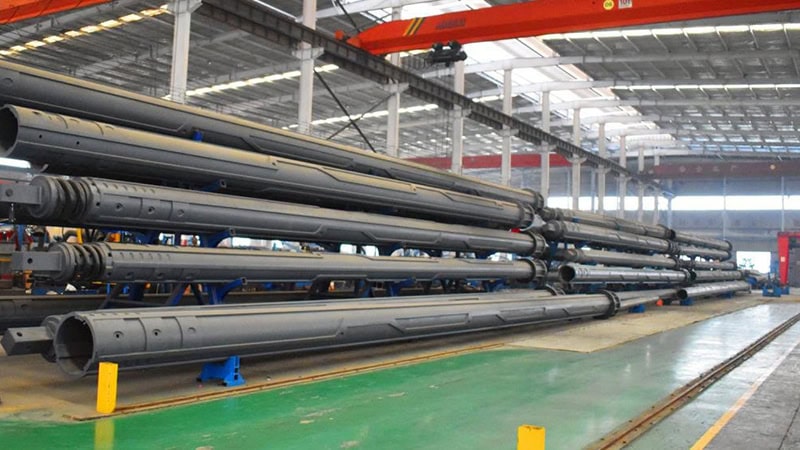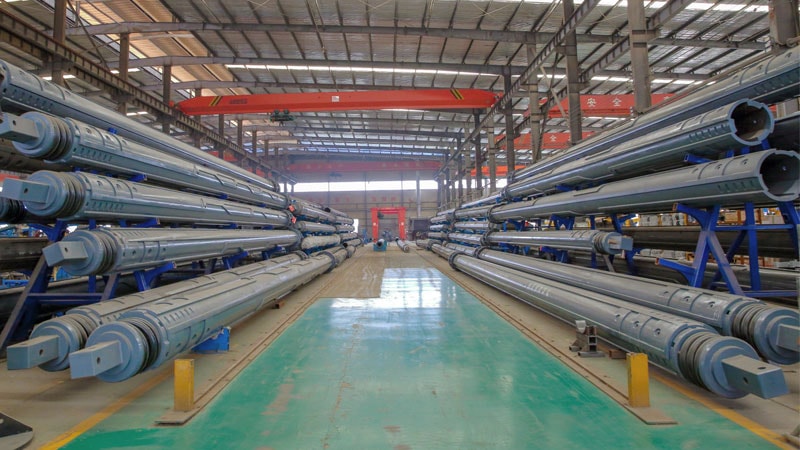
Key Takeaways:
- Proper maintenance for a Kelly bar reduces downtime, prevents wear, and extends service life, ensuring safe and efficient operations on any project.
- Daily and weekly cleaning, lubrication, and joint checks keep your equipment reliable and maintain consistent potency transfer during drilling.
- Regularly check for cracks, dents, or misalignment to address issues early and avoid costly component replacements.
- Following recommended practices for your piling rig ensures optimal performance, smooth operations, and long-term durability of all components.
In construction, maintenance for Kelly bars is more than routine—it safeguards operator safety, minimizes costly downtime, and extends equipment life. For Kelly bars, this involves monitoring damage, applying protective measures, and following a consistent care schedule.
Kelly bars are vital drilling rig components, driving force in rotary drilling to reach significant depths. Regular upkeep prevents premature wear, preserves efficiency, and ensures uninterrupted site productivity.
This guide outlines key maintenance tips, including inspecting for cracks and damaged parts, lubricating moving components, and scheduling professional checks. Following Everstar’s recommended best practices helps maintain top performance and reduce long-term costs.
Why Kelly Bar Maintenance Is Essential for Drilling Operations

In drilling operations, proper care ensures rigs operate safely and reliably. It prevents mechanical issues, reduces downtime, and helps maintain an optimal working condition, keeping your projects on schedule and under control. Proper maintenance also ensures Kelly bars can handle a wide range of drilling conditions efficiently, adapting to various geological and environmental scenarios.
Regular cleaning of Kelly bars is necessary to prevent the accumulation of drilling mud before inspection.
How Kelly Bars Impact Rig Efficiency and Drilling Output
Kelly bars ensure proper rotary transmission and crowd force, supporting precision and consistent pile driving. Stability is crucial, as secure locking of Kelly bars maintains efficient and safe drilling operations. Neglecting maintenance can cause vibrations, misalignment, and higher fuel use, reducing drilling efficiency and slowing operations.
Long-Term Cost Savings with Preventive Maintenance
Regular preventive care minimizes component replacements, reduces unexpected downtime, and lowers repair costs. Keeping Kelly bars in optimal condition ensures your drilling operations remain efficient while protecting long-term project budgets.
Daily and Weekly Maintenance Routines for Kelly Bars

Proper maintenance in drilling operations includes daily and weekly routines that address dents, misalignments, and joint integrity. Always check for broken components and address them promptly to prevent equipment failure. Following these inspections, combined with lubrication and cleaning protocols, keeps components in optimal working condition.
After every shift, it’s necessary to clean the sludge on the Kelly bars before performing maintenance work.
Daily Inspection Checklist Before and After Use
Perform a visual inspection for cracks, dents, and misalignments before and after operation.
Check the length of the Kelly bar and its sections for any discrepancies or signs of wear.
Check interlocking bars and locking mechanisms for proper function, and lubricate joints and guide rails, particularly on friction-type Kelly bars, to prevent damage.
Weekly Lubrication and Cleaning Protocols
Use compatible greases and oils depending on soil conditions, and clean outer keys, drive ribs, and key plates to remove abrasive debris. Detach and inspect components like flanges and drive heads to ensure smooth, reliable operation.
Signs of Wear and When to Intervene
Timely intervention is crucial for safety and performance. Monitoring surface wear and damage, as well as vibration consistency, helps detect issues early, preventing damage to your Kelly bars and keeping them performing at peak efficiency. Check welded joints for cracks or signs of failure, and address any issues through proper welding repairs to maintain structural integrity.
Surface Damage to Key Components
Check for worn key plates, cracks near welds, outer sections, and discoloration from overheating—for example, in Kelly bars. These signs indicate when replacement or maintenance is needed to prevent failures and ensure reliable drilling performance.
Vibration and Torque Inconsistency During Drilling
Inconsistent rotational force or excessive vibration signals poor maintenance, misalignment, or wear. Addressing these issues promptly prevents unstable drilling, reduces component stress, and maintains smooth, efficient operation throughout your project.
Regular inspections and careful handling, as emphasized by OSHA, are essential to avoid equipment failures and maintain a safe work environment. Following manufacturer guidelines and training personnel on proper rig operation further supports consistent, safe drilling performance.
Protective Measures to Extend Drill Rig Service Life
Protective measures complement regular maintenance, helping prevent corrosion, surface damage, and premature wear. Proper coatings, careful handling, and correct storage ensure your Kelly bar remains in good working condition for longer, maximizing drilling reliability.
Surface Coatings and Anti-Corrosion Treatments
In wet, saline, or abrasive drilling environments, applying protective coatings is crucial to prevent rust, corrosion, and wear. Regularly reapply chrome plating, hard alloy coatings, or anti-rust paint to maintain component integrity and ensure consistent performance.
Correct Handling, Transport, and Storage Practices
Always use proper lifting tools to avoid bending or damaging the Kelly bar. Store bars horizontally on padded supports, cover them with a tarp, or keep them indoors to shield against rain, UV exposure, and environmental hazards.
Maintenance Best Practices by Kelly Bar Type

Inspection is crucial for all Kelly bars. Checking both interlocking and types ensures reliability, proper torque transmission, and optimal working conditions. There are several types of Kelly bars, each designed for specific drilling applications, so selecting the appropriate type is essential for optimal performance and safety, keeping your drilling rigs performing safely and efficiently.
Friction Kelly Bars
For a friction Kelly bar, focus on lubricating sliding rails and guide surfaces. Torque is transmitted through the friction between the inner and outer sections, which is essential for effective soil drilling. At Everstar, we recommend paying special attention to surface deterioration on outer elements, as it affects smooth movement and overall drilling accuracy.
Interlocking Kelly Bars – Drilling Rig
For interlocking Kelly bars, inspect drive ribs, locking slots, and mechanical joints on your drill rig. Monitor locking integrity and internal tolerances to prevent misalignment and maintain consistent force transfer during operations.
When and How to Schedule Professional Inspections

Professional inspections are essential because daily and weekly routines may not catch all fatigue signs. Following manufacturer guidance based on usage hours ensures Kelly bars remain reliable and suitable for your drilling rigs. When planning inspection schedules, consider factors such as capacity, expected drilling depth, and site conditions to ensure optimal performance and safety.
Recommended Inspection Frequency Based on Usage Hours
Track operating hours to anticipate wear and fatigue. For interlocking Kelly bars, inspections are recommended every 400–600 hours to maintain performance, prevent unexpected failures, and ensure consistent torque transmission.
Partnering With the Manufacturer for Long-Term Support
Rely on manufacturer guidance to ensure proper installation and rig compatibility. Everstar Machinery provides technical documentation, updated maintenance practices, and expert support to help keep your Kelly bar in peak condition.
FAQs – Kelly Bar Maintenance
What is the maintenance schedule for Kelly bars?
Regular maintenance is critical for a Kelly bar, taking into account drilling depth, applied vertical force, and equipment load. Performing consistent daily and weekly inspections, cleaning, and lubrication of the Kelly bar ensures peak performance, reduces abrasion, and extends service life.
How do I know when my drilling Kelly bar needs replacement?
For a piling rig, carefully check the lock kelly bar mechanisms, drive ribs, and key plates. Signs such as cracks, visible damage, misalignment, or unusual vibrations on your drill rig indicate that replacement or professional maintenance is necessary to ensure safe, efficient operation.
What are the most common maintenance mistakes with Kelly bars?
Common errors on drilling rigs include skipping regular lubrication, overlooking surface degradation, delaying inspections, and failing to follow manufacturer guidelines.
Neglecting proper maintenance can lead to torque inconsistency, premature damage of critical parts, reduced drilling efficiency, and increased risk of operational downtime.
How do protective coatings help Kelly bar durability?
Protective coatings and anti-corrosion treatments shield Kelly bars from harsh conditions like wet, saline, or abrasive environments.
These measures maintain structural integrity, reduce degradation on critical components, prevent rust or corrosion, and extend the overall lifespan of your drilling equipment, ensuring long-term performance.
Conclusion – Keep Your Drilling Rigs Performing at Its Best
Kelly bars are vital drilling rig components, driving force in rotary drilling to reach significant depths. They are capable of drilling at great depths and offer versatility by adapting to various drilling conditions.
Kelly bars transmit torque to the drilling tool, which improves the drilling process by maintaining force, stability, and effectiveness during challenging operations.
By following the maintenance guidance and best practices outlined above, your drilling rigs remain efficient and reliable. Well-maintained Kelly bars last longer and support smoother, more precise drilling with minimal downtime.
Boost Your Kelly Bar Performance Now
Need help maintaining your kelly bar or sourcing high-performance replacements? Contact Everstar Machinery to speak with our team or explore our durable, corrosion-resistant kelly bar and accessories, built for your rig and optimized for any terrain. Check out the catalog for full equipment details.